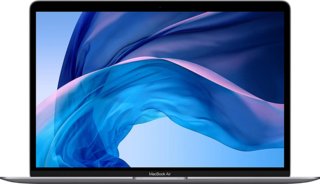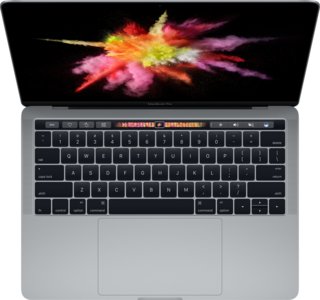Apple MacBook Air (2020) 13.3" Intel Core i3 vs Apple MacBook Pro (2017) 13" with Touch Bar and Touch ID / Intel Core i5 256GB
Struggling to choose between the Apple MacBook Air (2020) and the MacBook Pro (2017)? Here's some simple guidance to support your choice. In terms of performance, the MacBook Pro has an advantage with its exceptional processing power, making it ideal for intensive tasks such as video editing or graphic design. That said, both models efficiently perform routine tasks like web surfing and video streaming.
When it comes to design, the MacBook Air is slim and lightweight, ideal for individuals constantly on the go. In contrast, the MacBook Pro provides a slightly larger screen and extra ports for enhanced connectivity, highlighting its practicality.
In terms of user experience, both these laptops provide a seamless experience with their user-friendly macOS interface. The Pro offers more power than the Air but comes at a higher price.
If you're a creative professional in need of strong capabilities or searching for a dependable laptop for everyday tasks, our goal is to help you make an informed choice easily. You don't need to be tech-savvy; we've streamlined everything so you can confidently explore these options. Ready to get started? Let's compare!
System and application performance
Performance in popular 3D games
Viewing angle, color accuracy...
Ports, webcam and other interfaces
Potential battery life
Materials, durability and portability
Design Comparison
Size Comparison
When we compare the Apple MacBook Air (2020) and the Apple MacBook Pro (2017) concerning design elements that improve user experience, various important factors should be considered. Let's explore how these design features impact practical use and visual attractiveness to cater to diverse user requirements.
Design Elements
Ergonomics
- Both laptops are similar in weight, width, height, and thickness, providing a compact and portable design ideal for users who are often on the move. The backlit keyboard on both models improves typing accuracy and comfort in low-light conditions.
Materials & Build Quality
- Both laptops feature Apple's iconic high-quality aluminum construction, guaranteeing durability and a luxurious touch.
- The MacBook Air and MacBook Pro feature a stylish design with meticulous finishing touches, appealing to professionals who prioritize both looks and performance.
Portability
- Weighing 2.8 pounds for the MacBook Air and 3 pounds for the MacBook Pro, these laptops are portable options suitable for students and professionals on the go.
- With a slim 0.6-inch form factor, they are highly portable while maintaining high performance.
Unique Design Features
The Touch Bar on the MacBook Pro provides context-specific shortcuts tailored to the current application, boosting efficiency for creative professionals and power users.
- Both laptops come with multiple U
SB-C ports for flexible connectivity, making it easy for users to connect different devices.
Practical Usability
Students
The laptops' lightweight design makes them perfect for students requiring portability between classes or study sessions.
- The backlit keyboard is helpful for studying at night or in low-light settings.
Professionals
- Professionals are drawn to the premium build quality of both laptops, which offer a sophisticated yet functional option for work. The Touch Bar on the MacBook Pro offers convenient access to tools that enhance workflow efficiency in creative industries such as graphic design and video editing.
Aesthetic Appeal
MacBook Air (2020)
The MacBook Air's slim profile and sleek design exude elegance, appealing to users who prefer a minimalist aesthetic. The color options provide personalization for users who want their device to reflect their style preferences.
MacBook Pro (2017)
- Adding the Touch Bar to the MacBook Pro's design brings a modern element that caters to users valuing innovative features for improved user interaction.
- Users who value screen space may find the slightly larger screen-to-body ratio of the MacBook Air appealing.
Conclusion
In summary, the Apple MacBook Air (2020) and the Apple MacBook Pro (2017) each present distinctive design features tailored to diverse user requirements. The MacBook Air prioritizes portability and minimalist style, ideal for students and general users, whereas the MacBook Pro shines with its Touch Bar technology and high-end design, catering to creative professionals.
Screen Comparison
| Apple MacBook Air (2020) 13.3" Intel Core i3 | Apple MacBook Pro (2017) 13" with Touch Bar and Touch ID Intel Core i5 256GB | |
|---|---|---|
| Resolution | QHD | QHD |
| Screen Size | 13.3" | 13" |
Comparing the screens of the Apple MacBook Air (2020) and the Apple MacBook Pro (2017) reveals both laptops feature a 13.3-inch display with a resolution of 2560 x 1440 pixels and a pixel density of 227 ppi. However, distinctions in other screen-related features exist that could affect user experience in tasks such as gaming or professional graphic design.
Screen Size
- MacBook Air (2020): The 13.3-inch screen size offers a balanced combination of portability and usability.
- MacBook Pro (2017): The model with Touch Bar also includes a 13.3-inch display, providing ample space for work and entertainment.
Display TechnologyMacBook Air (2020) features an IPS LCD with LED-backlit technology, providing vibrant colors and wide viewing angles.
- MacBook Pro (2017): Its display incorporates IPS LCD with LED-backlit technology, ensuring color accuracy from all viewing angles.
Practical Examples:
Gaming: Both laptops offer a similar resolution and pixel density, which can enhance gaming experiences by providing sharp visuals and detailed graphics. However, for more demanding games that require precise color accuracy, the MacBook Pro's slightly better color reproduction may offer a slight advantage.
- Professional Graphic Design: High-resolution displays, such as those found on laptops, are essential for design tasks. The IPS panels guarantee precise color reproduction, a crucial aspect of graphic design work. Designers can take advantage of the expansive color gamut and uniform brightness levels provided by these displays.
In summary, although the screen specifications of the MacBook Air (2020) and MacBook Pro (2017) share similarities in resolution and pixel density, distinctions in display technology could result in subtle differences in color accuracy and brightness. For activities such as gaming or graphic design that require precise visual clarity, users may discern nuanced variances between the models influenced by these aspects.
Hardware Comparison
| Apple MacBook Air (2020) 13.3" Intel Core i3 | Apple MacBook Pro (2017) 13" with Touch Bar and Touch ID Intel Core i5 256GB | |
|---|---|---|
| CPU | Intel Core i3 | Intel Core i5 |
| RAM | 8GB | 8GB |
| Storage Size | 256GB | 256GB |
Comparing the hardware of the Apple MacBook Air (2020) 13.3" with Intel Core i3 1.1GHz / 8GB RAM / 256GB SSD and the Apple MacBook Pro (2017) 13" with Touch Bar and Touch ID featuring Intel Core i5 3.1GHz / 8GB RAM / 256GB SSD reveals crucial factors that can impact your choice.
CPU (Central Processing Unit):
- MacBook Air: Comes with an Intel Core i3 processor running at a base speed of 1.1GHz, capable of turbo boosting up to 3.2GHz for more demanding tasks.
- MacBook Pro: Boasts a robust Intel Core i5 processor that operates at a base speed of 3.1GHz, capable of turbo boosting up to 3.3GHz.
Performance Impact: The increased clock speeds of the MacBook Pro's Core i5 processor deliver improved performance for demanding tasks like video editing, software development, and multitasking.
GPU (Graphics Processing Unit):
- Unlike high-performance laptops that commonly feature discrete GPUs, both laptops utilize integrated graphics. Integrated graphics processors use system memory for handling graphics tasks.
Performance Impact: Casual users performing routine tasks such as web browsing or document editing will find the integrated graphics on both models adequate. However, those engaging in visually demanding activities like gaming or video editing may experience varying performance levels between the two laptops due to the superior capabilities of the MacBook Pro's integrated GPU.
RAM (Random Access Memory):
- MacBook Air: Equipped with 8GB of RAM clocked at a rapid 3733MHz.
- MacBook Pro: Comes with 8GB of RAM, operating at a speed of 2133MHz.
Performance Impact: The quicker RAM in the MacBook Air can result in smoother performance when multitasking or running memory-intensive applications. Despite this, both laptops provide enough memory for daily activities such as web browsing, word processing, and multimedia use.
In conclusion:
- MacBook Air (2020): Suitable for everyday tasks and basic multitasking thanks to its moderate specifications, although may face challenges with resource-intensive activities such as video editing or gaming.
- MacBook Pro (2017): Provides improved performance capabilities with a more powerful CPU and slightly faster GPU in comparison to the MacBook Air.
Consider your specific requirements and budget when selecting a laptop. For everyday tasks, the MacBook Air is a reliable and cost-effective choice for casual users or students. Conversely, professionals needing greater processing power may prefer the MacBook Pro to meet their needs.
Battery Comparison
| Apple MacBook Air (2020) 13.3" Intel Core i3 | Apple MacBook Pro (2017) 13" with Touch Bar and Touch ID Intel Core i5 256GB | |
|---|---|---|
| Battery Life | 11 hours | 10 hours |
When comparing the battery life of the Apple MacBook Air (2020) and the Apple MacBook Pro (2017), there are some key differences to consider:
Apple MacBook Air (2020) 13.3" equipped with Intel Core i3 1.1GHz, 8GB RAM, and a 256 GB SSD:
- Battery Life: Provides an impressive 11 hours of usage on a single charge, ensuring extended productivity without the need for frequent recharging.
- Sleep And Charge USB Ports: Charge your devices while your laptop is in sleep mode for added convenience and versatility.
Apple MacBook Pro (2017) 13" with Touch Bar and Touch ID featuring Intel Core i5 3.1GHz, 8GB RAM, and 256GB storage:
- Battery Life: Provides a solid 10 hours of battery life, suitable for most users' daily tasks and productivity on the go.
When comparing the Apple MacBook Air (2020) and the Apple MacBook Pro (2017), both offer sufficient battery life for work or entertainment. The extra hour of battery on the MacBook Air (2020) may benefit users needing prolonged usage without a power source.
Verdict
Why Apple MacBook Air (2020) 13.3" Intel Core i3?
- The Apple MacBook Air (2020) is lighter and more portable, making it ideal for users constantly on the move.
- The MacBook Air (2020) offers a longer battery life of up to 11 hours, providing extended productivity without frequent recharging.
- With a lower price point compared to the MacBook Pro (2017), the MacBook Air (2020) is a cost-effective choice for casual users or students.
Why ?
- The MacBook Pro (2017) offers a more powerful Intel Core i5 processor for improved performance in demanding tasks.
- It features the innovative Touch Bar technology that enhances workflow efficiency, particularly beneficial for creative professionals.
- The MacBook Pro (2017) has a slightly larger screen size and more ports for enhanced connectivity options.
Similar comparisons
- Apple MacBook (2016) vs Apple MacBook Air (2020) 13.3" Intel Core i3
- Apple MacBook Air (2017) 13.3" Intel Core i7 vs Apple MacBook Pro (2017) 13" with Touch Bar and Touch ID / Intel Core i5 256GB
- Apple MacBook Air (2020) 13.3" Apple M1 vs Razer Blade Stealth RZ09 12.5" Intel Core i7-6500U
- Apple MacBook Air (2020) 13.3" Apple M1 vs Microsoft Surface Pro 6
- Apple MacBook Air (2020) 13.3" Apple M1 vs Microsoft Surface Laptop Go 12.4" Intel Core i5-1035G1

